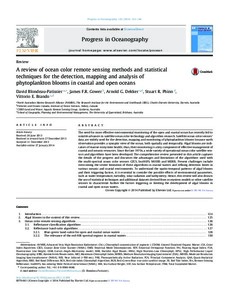| dc.contributor.author | Blondeau-Patissier, David | |
| dc.contributor.author | Gower, James F.R. | |
| dc.contributor.author | Dekker, Arnold G. | |
| dc.contributor.author | Phinn, Stuart R. | |
| dc.contributor.author | Brando, Vittorio E. | |
| dc.date.accessioned | 2021-01-05T16:36:16Z | |
| dc.date.available | 2021-01-05T16:36:16Z | |
| dc.date.issued | 2014 | |
| dc.identifier.citation | Blondeau-Patissier, D.; Gower, J.F.R.; Dekker, A.G.; Phinn, S.R. and Brando, V.E. (2014) A review of ocean color remote sensing methods and statistical techniques for the detection, mapping and analysis of phytoplankton blooms in coastal and open oceans.
Progress in Oceanography, 123, pp.123-144. DOI: https://doi.org/10.1016/j.pocean.2013.12.008. | en_US |
| dc.identifier.uri | http://hdl.handle.net/11329/1478 | |
| dc.identifier.uri | http://dx.doi.org/10.25607/OBP-980 | |
| dc.description.abstract | The need for more effective environmental monitoring of the open and coastal ocean has recently led to
notable advances in satellite ocean color technology and algorithm research. Satellite ocean color sensors’
data are widely used for the detection, mapping and monitoring of phytoplankton blooms because earth
observation provides a synoptic view of the ocean, both spatially and temporally. Algal blooms are indicators
of marine ecosystem health; thus, their monitoring is a key component of effective management of
coastal and oceanic resources. Since the late 1970s, a wide variety of operational ocean color satellite sensors
and algorithms have been developed. The comprehensive review presented in this article captures
the details of the progress and discusses the advantages and limitations of the algorithms used with
the multi-spectral ocean color sensors CZCS, SeaWiFS, MODIS and MERIS. Present challenges include
overcoming the severe limitation of these algorithms in coastal waters and refining detection limits in
various oceanic and coastal environments. To understand the spatio-temporal patterns of algal blooms
and their triggering factors, it is essential to consider the possible effects of environmental parameters,
such as water temperature, turbidity, solar radiation and bathymetry. Hence, this review will also discuss
the use of statistical techniques and additional datasets derived from ecosystem models or other satellite
sensors to characterize further the factors triggering or limiting the development of algal blooms in
coastal and open ocean waters. | en_US |
| dc.language.iso | en | en_US |
| dc.rights | Attribution-NonCommercial-ShareAlike 4.0 International | * |
| dc.rights.uri | http://creativecommons.org/licenses/by-nc-sa/4.0/ | * |
| dc.subject.other | Harmful Algal Blooms | en_US |
| dc.subject.other | Ocean colour | en_US |
| dc.subject.other | Sensors | en_US |
| dc.subject.other | Ocean colour remote sensing | en_US |
| dc.subject.other | Satellite ocean colour | en_US |
| dc.subject.other | Phytoplankton | en_US |
| dc.title | A review of ocean color remote sensing methods and statistical techniques for the detection, mapping and analysis of phytoplankton blooms in coastal and open oceans. | en_US |
| dc.type | Journal Contribution | en_US |
| dc.description.refereed | Refereed | en_US |
| dc.format.pagerange | pp.123-144 | en_US |
| dc.identifier.doi | https://doi.org/10.1016/j.pocean.2013.12.008 | |
| dc.subject.parameterDiscipline | Parameter Discipline::Biological oceanography::Phytoplankton | en_US |
| dc.bibliographicCitation.title | Progress in Oceanography | en_US |
| dc.bibliographicCitation.volume | 123 | en_US |
| dc.description.sdg | 14.5 | en_US |
| dc.description.eov | Phytoplankton biomass and diversity | en_US |
| dc.description.eov | Ocean colour | en_US |
| dc.description.bptype | Manual (incl. handbook, guide, cookbook etc) | en_US |
| obps.contact.contactname | David Blondeau-Patissier | |
| obps.contact.contactemail | David.Blondeau-Patissier@cdu.edu.au | |
| obps.resourceurl.publisher | https://www.sciencedirect.com/science/article/pii/S0079661114000020 | en_US |
 Repository of community practices in Ocean Research, Applications and Data/Information Management
Repository of community practices in Ocean Research, Applications and Data/Information Management

